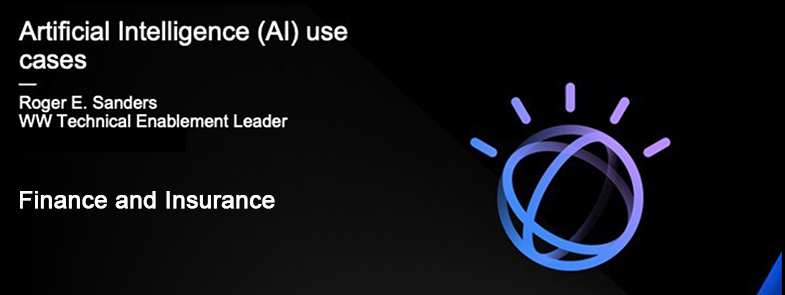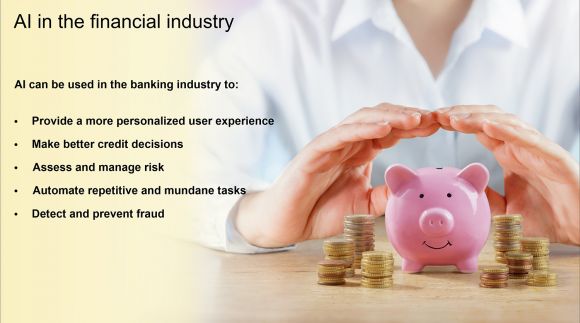Artificial intelligence (AI) and machine learning (ML) are revolutionizing the financial world.
The implications are vast, though most banks are still in the early stages of adopting these technologies – a recent survey conducted by Narrative Science and the National Business Research Institute found that 32% of financial services executives are already using AI technologies like predictive analytics, recommendation engines, and voice recognition.
To illustrate the efficiency of using AI, in 2016, the 5 largest and most influential banks in the US closed more than 400 local branches and still met their margin thresholds. Mobile banking combined with ML helped them meet and exceed their customer’s expectations.
Just a sample of ways in which AI, ML, and deep learning (DL) can help improve the banking and financial industry include:
- Provide a more personalized user experience: While consumers and businesses want a safe, low-risk approach to financial management, they also value unique One way AI, ML, and DL can be used in this area is to provide customers with reminders to pay bills, suggest financial planning tools, and offer other perks that make it easier to understand and track personal finances. Another is to analyze customer data and recognize unusual behavior based on financial and purchase history. For example, Capital One notifies customers if their card was charged twice for an item or if they tipped an exorbitant amount at a restaurant.
- Make better credit decisions: Banks have a lot of data on their customers that can be used to determine which credit applicants are higher risk and which applicants are more credit-worthy. AI-based credit scoring can provide a faster, more accurate assessment that banks can trust, as well as help detect and eliminate bias when making loan approval decisions.
- Assess and manage risk: By automating credit risk testing, banks can receive accurate risk assessment reports And, when properly trained on historical risk case data, ML models can help banks forecast potential risks so they can take early steps to avoid them. Similar models can help individual portfolio holders assess risk so they can make better financial decisions.
- Automate repetitive and mundane tasks: Process automation frees up resources and capacity to provide better service to Thus, by using robotic process automation (RPA), banks can eliminate human error and restructure their workforce so they can focus on more pressing tasks. One example is the use of chatbots to provide quick and reliable answers to consumers' questions. Using AI-powered mobile and web chatbots, banks can decrease the need for employees to answer questions and speed up the time it takes for consumers to receive answers.
- Detect and prevent fraud: Fraud is an element that plagues almost every financial By analyzing spending patterns, location, and customer behavior, ML models can detect anomalies in spending habits and flag suspicious behavior, at which point a customer can be asked to provide additional information. Or, models can block a suspicious transaction altogether. This means that banks can catch fraud as it happens, in real-time, instead of having to rectify the situation after it has occurred. And AI’s ability to continually learn and become smarter can help financial institutions close vulnerabilities faster and more often.
Source:
How AI and machine learning are improving the banking experience: (Techradar)
http://techradar.com/news/how-ai-and-machine-learning-our-improving-the-banking-experience
Insurance
By definition, insurance is an industry that’s predominantly built around risk. Consequently, insurance companies depend greatly on their ability to predict what risks a person, company, or organization represents and their ability to make accurate predictions can have a tremendous impact on their bottom line. According to a survey that was conducted in 2017, most insurance company CEOs are concerned about industry regulation, shifting customer behavior, competition from new companies entering the market, and the pace of technological change. So, insurance companies are acutely aware of the disruption and change their industry is facing. Moreover, an article titled Insurance 2030—The impact of AI on the future of insurance, published by McKinsey & Company in 2021 states that “Rapid advances in technologies in the next decade will lead to disruptive changes in the insurance industry. The winners in AI-based insurance will be carriers that use new technologies to create innovative products, harness cognitive learning insights from new data sources, streamline processes and lower costs, and exceed customer expectations for individualization and dynamic adaptation.” In other words, carriers that focus on creating opportunities by using artificial intelligence (AI), machine learning (ML), and deep learning (DL) can expect to thrive over the next decade.
As it has done for major leaders in other industries, AI, ML, and DL can help insurance companies deliver service with better efficiency and quality. Other areas where AI, ML, and DL can help include:
- Fraud detection: Statistics show that up to 10% of insurance claims costs are related to fraud. By analyzing historical data, ML models can examine the alleged events of an accident during claims processing to help confirm whether an asserted claim is true. If an event or claim deviates from an established, normal pattern, it can be flagged, at which point a claims expert can be asked to investigate it further. And because AI can continually learn and become smarter, its use could help identify fraudulent claims faster and more often.
- Claims management: The process of filing a claim has not changed much over the years – it’s heavily paper-based and highly dependent on a specific execution. This not only frustrates customers filing claims, but the process is quite daunting for insurance company employees as well. AI can be used to automate and accelerate this process. For example, AI could be used to auto-validate policies before paying on a claim by confirming that key facts in the claim match what’s outlined in a policy. ML models could gauge incident severity by processing images captured by the insured at the place where the incident occurred.
With the help of technologies like Natural Language Processing (NLP), speech-based claims could be accepted and converted to text, making the process of documenting and managing claims easier and more efficient. Chatbots could be used during the initial part of the claims process to help customers report incidents without requiring human intervention. And AI could help detect and remove bias such as address, income, race, gender, sexual orientation, and other variables when claims are processed.
- Underwriting and loss prevention: Insurance companies rely on specialized knowledge in risk assessment, together with data, to determine whether they will insure something or someone, and if so, at what cost. AI has the potential to take underwriting from a “detect-and-repair” mindset to a “predict-and-prevent” philosophy. For example, life insurance underwriters could take advantage of ML models that automatically incorporate information about a person’s prescription drug history, gym club memberships, shopping habits, and travel plans into risk assessment. (They might also work with their clients to help them adopt healthier lifestyles by offering discounts for better health practices – a “win-win” situation.) On the other hand, commercial property underwriters could utilize ML models that analyze public data to learn the locations of a company’s plants around the world, understand the type of machinery used inside each plant, the number of workers at each plant, their skill sets, and plant safety violation history.
- Marketing and customer experience: Insurance is a competitive market, so a strong marketing strategy is vital. Using AI, it’s possible to get a clearer picture of target audiences, as well as identify potential customers and deliver a marketing message that’s most relevant to them. Shaped by experiences with other industries, insurance customers – particularly millennials – now expect fast, on-demand services. AI chatbots can be used to improve the overall customer experience by answering questions, giving basic advice, resolving complaints, and reviewing claims. More importantly, chatbots are available 24/7. (Insurers already using chatbots include startup Lemonade, Geico, Allstate, Lincoln Financial, and others.)
- Financial assets: The insurance industry is controlled, to a large extent, by government policies, budgets, and industry regulations. AI can improve the ability to react quickly to changing trends, as well as identify opportunities and challenges early on by analyzing news and social media. AI can also be used to refine risk tables by automatically auditing costly claims. For example, with auto claims, AI could look for patterns in vehicle type, accident location, weather conditions, and driving style. With other types of claims, AI might look for patterns like geography, season, time of day, day of week, proximity of change to/from daylight savings time, age, income, gender, and more. This information could then be used to help predict future costs of policies, better align and tailor policies to individual needs, and predict future coverage requirements. AI could also be used to analyze investor calls with asset providers to identify anomalies, as well as help insurance companies manage assets efficiently.
Sources:
Insurance 2030—The impact of AI on the future of insurance: (McKinsey & Company)
https://www.mckinsey.com/industries/financial-services/our-insights/insurance-2030-the-impact-of-ai-on-the-future-of-insurance
How AI and machine learning are helping the insurance industry: (Atrium)
https://atrium.ai/resources/how-ai-and-machine-learning-are-helping-the-insurance-industry/
20th CEO Survey / Key findings in the Insurance industry / February 2017: (PricewaterhouseCoopers)
https://www.pwc.com/gx/en/ceo-survey/2017/industries/pwc-ceo-20th-survey-report-2017-insurance.pdf
Stay Tuned
In the next part of this article series, we’ll take a look at how AI, ML, and DL are being used in the healthcare industry.



























 Business users want new applications now. Market and regulatory pressures require faster application updates and delivery into production. Your IBM i developers may be approaching retirement, and you see no sure way to fill their positions with experienced developers. In addition, you may be caught between maintaining your existing applications and the uncertainty of moving to something new.
Business users want new applications now. Market and regulatory pressures require faster application updates and delivery into production. Your IBM i developers may be approaching retirement, and you see no sure way to fill their positions with experienced developers. In addition, you may be caught between maintaining your existing applications and the uncertainty of moving to something new. IT managers hoping to find new IBM i talent are discovering that the pool of experienced RPG programmers and operators or administrators with intimate knowledge of the operating system and the applications that run on it is small. This begs the question: How will you manage the platform that supports such a big part of your business? This guide offers strategies and software suggestions to help you plan IT staffing and resources and smooth the transition after your AS/400 talent retires. Read on to learn:
IT managers hoping to find new IBM i talent are discovering that the pool of experienced RPG programmers and operators or administrators with intimate knowledge of the operating system and the applications that run on it is small. This begs the question: How will you manage the platform that supports such a big part of your business? This guide offers strategies and software suggestions to help you plan IT staffing and resources and smooth the transition after your AS/400 talent retires. Read on to learn:
LATEST COMMENTS
MC Press Online